
©1999-2003. All rights reserved.

|
Vietnam Book Reviews

Dispatches 
Michael
Herr
Alfred A. Knopf, 1977 - ISBN 0-330-49199-7 |
|
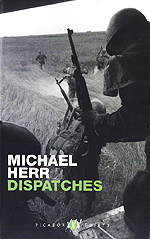 Publisher's Summary
Publisher's Summary
"In Dispatches Michael Herr brings the reader
right to the heart of the Vietnam War. These are his journals, written
with such immediacy and sympathy, such an insightful understanding of
the facades and falsities that surround him, that the reader is mesmerized.
With Dispatches Michael Herr comes close to achieving the impossible:
summing up the colossal waste of war, while keeping hold of the real
people, places and events that comprise it."
Review
Much of the writing in Dispatches verges on poetry,
such is the intense imaginativeness of the imagery. Herr was the co-author
of the scripts for Apocalypse Now and Full Metal Jacket,
and this shows in the book, which has a cinematic, melodramatic stamp.
It is packed with intensely quotable lines such as the atmospheric 'Saigon,
Cholon and Danang held such hostile vibes that you felt you were being
dry-sniped every time someone looked at you, and choppers fell out of
the sky like fat poisoned birds a hundred times a day', or the pithy
'There's nothing so embarrassing as when things go wrong in a war'.
From a factual point of view, Herr offers a viewpoint about as far
as from the dry, positive analyses from the Center of Military History
as it's possible to get. Herr was there on the ground and saw the human
side of the war, from savagery to laziness. If you want your games to
have the right feel, not just in terms of weapon ranges but in terms
of emotional choices then you need to absorb this one.
|

Nam 
Mark
Baker
Abacus, 1982 - ISBN 0-349-10239-2 |
|
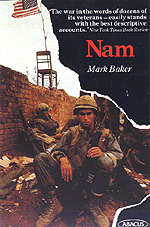 Publisher's Summary
Publisher's Summary
"The war billed on the marquee as a John Wayne shoot 'em up
test of manhood turns out to be a warped version of Peter Pan. Vietnam
was a brutal Neverneverland outside time and space, where little boys
didn't have to grow up. They just grew old before their time.
Even now something is missing from the history of Vietnam. Behind
the burning sense of horror and betrayal the personal stories remain
untold. No one has bothered to talk to the men and women who went to
Vietnam and fought the war.
What happened to the boys and girls straight out of school who were
plunged from the basketball park into the napalm jungle? Who were they
fighting for? How did conscripts and volunteers live through the war
and how can they now live with the scars?
Mark Baker recorded conversations with dozens of Vietnam veterans.
Nam is a unique and harrowing collection of those interviews,
as raw and shocking as an open wound. This is the story of the human
cost of a war that had no survivors, only veterans."
Review
Nam is a collection of one and two page sections of interviews
with veterans, grouped under headings such as 'Baptism of Fire' and 'Homecoming'.
There is no particular sequence or continuity and each section is completely
unattributed, (although you can often discover the role of the interviewee
from the content). Personally I found it too disjointed - the pile of
film on the cutting room bench waiting to be made up into something cohesive.
In addition, many of the sections contain fairly controversial content,
and the lack of any attributied sources somewhat undermined its credibility.
Nevertheless each section is well edited and contains some compelling
snippets. |

We Were Soldiers Once...And Young 
Lt.
Gen Harold G. Moore & Joseph L. Galloway
Harper Collins, 1992 - ISBN 0-06-097576-8 |
|
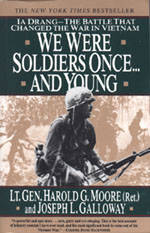 Publisher's Summary
Publisher's Summary
"In November 1965 some 450 men of the 1st Battalion, 7th Cavalry,
under the command of Lt. Col. Hal Moore, were dropped by helicopter
into a small clearing in the Ia Drang Valley. They were immediately
surrounded by 2,000 North Vietnamese soldiers. Three days later only
two and a half miles away, a sister battalion was chopped to pieces.
Together, these actions at the landing zones X-Ray and Albany constituted
one of the most savage and significant battles of the Vietnam War."
Review
As well as being a factual account of the battle the book is also a gripping
story. From the relentless stream of facts comes a detailed picture of
the developing situation from both a command and an individual level.
Moore shares the tactical dilemmas and the reasoning behind his decisions
in a way which makes you appreciate the skill required to command in battle. |
 Eric M. Bergerund
Eric M. Bergerund
1993, Westview Press - ISBN 0 14 02.3345 0 |
|
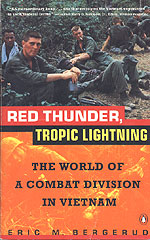 Publisher's Summary
Publisher's Summary
"Here are the Men of the 25th Infantry a division that knew intimately every cruel facet of the war. They bore the brunt of the Tet Offensive. They chased deadly shadows through the Viet Cong's infamous tunnel network. And they suffered the ordeal of jungle warfare: By 1971 their losses were among the highest in the army, with 5,000 men killed and many times that number wounded.
In this book the men of the 25th Division describe in their own words the frustration and torment that faced all American combat soldiers in Vietnam. Their story illustratews why the task given the U.S. Army proved so formidable and ultimately futile. It shows why brave and skillful fighting men could win battle after battle, but still not obtain a final victory. For anyone who remembers the Vietnam War, or wishes to understand it, this is an enlightening, heartbreaking history.
"
Review
This is an excellent book which describes all aspects of the division's action. It contains an overall strategic overview, individual accounts of battles and details of equipment and tactics.
|

The History of the Vietnam War
Charles T. Kamps Jr
1988 - ISBN 0-600-55783-9 |
|
Publisher's Summary
"With more than 700 colour and black and white photographs and illustrations.
The History of the Vietnam War documents U.S. involvement in South East Asia from the days of the first advisors to the lift-off of the last chopper from Saigon.
It was an unusual war. Vietnam saw the first large-scale of the helicopter in combat. Battlelines were not clear; jungle warfare presented constant changes. When the U.S. soldier was presented with conventional opposition, as in the Ia Drang valley, at Khe Sanh, or in the streets of Hue, he usually won. Most of the time there was no way of knowing who the enemy was, and so the endless patrolling through mud or dust was vital.
At sea, there was no real enemy, but the Navy was totally involved in the war. From the first clashes in the Gulf of Tonkin the carriers sent their aircraft striking deep into North Vietnam. Along the coasts, warships poured fire into Viet Cong positions in support of troops on the ground. In the murky waters of the Mekong Delta smaller river craft fought a vicious struggle to the end.
It was in the air that U.S. power was most obvious. Giant Boeing B-52s pulverized the Ho Chi Minh trail and Hanoi, as did tactical aircraft such as the F-105 Thunderchief. F-4 Phantoms tangled with MiGs over the North and unloaded huge amounts of ordnance over the South. Ageing propeller-driven fighter-bombers proved lethal to the Vietcong, and the helicopter was everywhere.
Vietnam was a war unlike any other in U.S. History. Unpopular at home and abroad, facing an elusive and dedicated enemy, the U.S. forces could not win a decisive victory. The U.S. forces fought a difficult war that will be studied and debated for years to come.
"
Review
This is a large and lavishly illustrated volume, with almost every page containing a number of photos. Almost every aspect of the war is covered to some extent, although this breadth means a certain lack of detail. The magazine like style makes it easy reading, and it includes a number of historical quotes from Newsweek etc. which help add flavour. There is also a good quantity of hard information, for example the appendices includes a number of Orders of Battle for 1968, US Army, NVA, Australian, Thai etc. |

The US Army in Vietnam 
Leroy
Thompson
David & Charles, 1990 - ISBN 0-71-539219-0 |
|
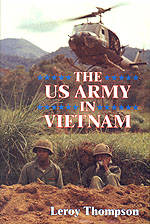 Publisher's Summary
Publisher's Summary
"In 'US Army in Vietnam' the military machine which went to
war in Vietnam is analysed for its strengths and its weaknesses. From
platoon to Corps Tactical Zone to Military Assistance Command Vietnam,
the organisation and manpower of infantry, armour and artillery are
covered in detail as well as the individual combat support arms which
make the US Army the most powerful in the world."
Review
This book is packed with factual information on all aspects of the army.
Artillery, armour, helicopters and special forces are all dealt with.
As well as describing equipment and organisation, their battlefield
roles are described and commented on. There is also a particularly interesting
section describing the '2 1/2' war concept used by the Johnson and Kennedy
administration which explains how Vietnam fitted into the overall US
Cold War defense strategy. Initially designated as the 1/2 war it expanded
to at least a 1 1/4 war which depleted the entire strategic reserve.
This is great material for the Vietnam wargamer, but I think it is
out of print and may be difficult to find. I picked this copy up for
only £5 from an army surplus shop on Abbeydale Road, Sheffield,
UK, which had a stock of them.
|

Sky Soldiers
F.
Clifton Berry Jr
Bantam Books, 1987 - ISBN 0-553-34320-3 |
|
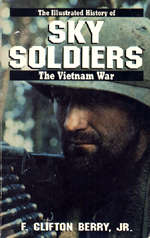 Publisher's
Summary Publisher's
Summary
"The 173d Airborne was the first major American ground combat
units to launch offensive operations in a major parachute attack. The
all-volunteer elite force pioneered the tactics for airmobile attacks
in Vietnam. Deployed by the generals in Saigon as a ' Fire Brigade'
unit, the Sky Soldiers were sent to where the fighting was hottest.
And nowhere was it more fierce than in the hard-fought border battles
for Dak To and Hill 875."
Review
Sky Soldiers is a good general wargaming resource, as it covers all
aspects of this unit in reasonable detail, rather than concentrating on
one specific topic such as uniforms. Based around a chronology of the
brigade's deployment in Vietnam from 1965 to 1970, it also contains accounts
of specific engagements including diagrams, and some discussion of equipment
and tactics. For a fairly small book there is a surprising amount of information
packed into it, and there is plenty of specific numerical detail to help
construct realistic scenarios. The author was operations officer for the
196 Light Infantry Brigade, so presumably he knows what he is talking
about, although there is a noticeable lack of criticism of any aspect
of their operations. |

Telltale Hearts - The Origins and Impact of the Vietnam
AntiWar Movement 
Adam
Garfinkle |
|
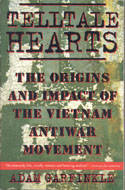 Review
Review
The primary thesis of this book is that the results of the radical anti-war
movement were not those which are commonly assumed by both 'hawks' and
'doves'. Instead of it helping to turn the American public against the
war, it served to prolong US involvement by marginalizing the anti-war
perspective. Many who would have spoken against the continuation of
US intervention in Vietnam at an earlier stage in the war did not do
so because it would have meant being associated with the radical fringe
whose 'drugs, radical left politics and free love' image was distasteful
to a large section of the American public.
Garfinkle argues that the public opinion was led predominantly by
the administration itself. When support began to degrade in 1968, it
was not the Tet itself which triggered the slide. A month later in February
a Gallup poll, which asked whether people considered themselves hawks
or doves, resulted in 61% rating themselves as hawks and only 23% as
doves. It was a dominant view that as a considerable cost in lives and
dollars had already been incurred, the only way was forward. However
after LBJs speech in March 1968 when he announced that they would attempt
negotiations to end the war and halt the bombing, public support plummeted.
The government had shown that it did not believe itself that the war
could be won, and that the best outcome that could be hoped for was
that the US could disentangle itself with as little further pain as
possible. In spite of this in 1970 the majority of the public still
opposed a unilateral withdrawal from Vietnam, a stance more hawkish
than the government. He further believes that the war was winnable,
and not through giving the military a free hand, as is now commonly
argued. Much of US strategy ignored the principal objective - that of
a non-Communist, democratic government in South Vietnam. The very scale
of the US involvement undermined and corrupted the Saigon government
and destroyed any nationalist credentials which it was entitled to claim.
Furthermore military objectives are of little value if the ultimate
victory which is sought is primarily a political one. If every military
asset of the VC had been destroyed, but in the process the populace
had been alienated and made hostile to the US and pro-American Vietnamese
politicians, then the US would have failed. Success should have been
counted in terms of friendly populace, not dead Communists. Although
this book has few military facts that would be useful to wargamers,
its unusual approach to the politics underpinning the US administration's
strategic decisions makes fascinating reading. It could also provide
useful themes and political information for a Matrix style game or a
map based campaign where the players control the whole of US involvement
in RVN and juggle military and political objectives.
|

Armies of the Vietnam War 1962-75 
Philip
Katcher & Mike Chappell
Osprey Publishing, 1980 - ISBN 0-85045-360-7 |
|
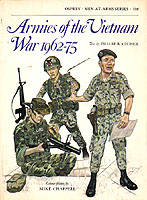 Review Review
Most wargamers will be familiar with the Osprey series of hundreds of
books spanning centuries of warfare. They describe in detail the appearance
and equipment of units, as well as a small amount of history about the
war and their deployment.
The uniform descriptions are illustrated by 8 colour plates of groups
of troops such as the one which appears on the cover. These are particularly
useful as a uniform source. Real colour photos are often difficult to
use because the dust and dirt on the uniforms as well as lighting conditions
can make it difficult to pick out colours and patterns.
It also contains black and white photos illustrating a wide range of
troop types and equipment and diagrams of rank markings.
|

Armies of the Vietnam War 2 
Lee
E Russell Katcher & Mike Chappell
Osprey Publishing, 1983 - ISBN 0-85045-514-6 |
|
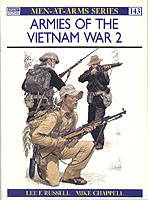 Review Review
This volume is a sequel to the book above. Both contain a general overview
of both sides, so it is not necessary to have both. As before it contains
8 colour plates in addition to black and white photographs.
This one contains more information on the Communist soldiers than the
previous volume, and also contains some pictures of Special Forces.
|

If I Die in a Combat Zone 
Tim
O'Brien |
|
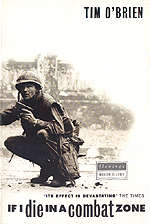 Review Review
A fictionalised account of the author's training and tour of duty. O'Brien
was drafted, but in spite of having misgivings about the war, he was
set on a course which he found himself unable to change.
There isn't a great deal of military information, except for some evocative
snippets of combat and patrolling from the infantryman's perspective.
He recounts actually seeing some armed enemy only once in the entire
year, and even then they are too far away to engage. The rest of the time
his company plods through booby traps and faked ambushes. O'Brien paints
his characters in a brief and elegant way and their reaction to the
situations they find themselves in is highly compelling and realistic.
Golden moments include his captain failing to report an enemy ambush
because he can't be bothered to 'mess around with gunships', the idiot
Texan Captain who comes within a hair's breadth of being fragged and
the frenzied firing at nothing at the beginning.
By turns funny and moving, this is a must-read for anyone at all, let
alone those with a particular interest in Vietnam.
|

Going after Cacciato 
Tim
O'Brien
Jonathan Cape, 1978 - ISBN 0-00-654307-3 |
|
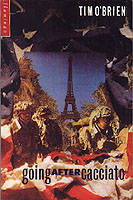 Publisher's
Summary Publisher's
Summary
"Going after Cacciato begins one rainy day in Vietnam when a
pleasant, moon-faced soldier named Cacciato decides that, all things
considered he'd rather be in Paris, even if he has to walk there all
8,600 miles. The men of Third squad, First Platoon, Alpha Company, set
out in pursuit - to find him, to bring him back. The result is a magnificent
journey of the imagination through war and peace. Part dream, part reality,
this extraordinary and beautiful novel has been hailed as a modern classic."
Review
This seemed to be a novel set in Vietnam rather than a novel about Vietnam, and didn't convey its specific atmosphere with the vivid quality of 'If I die in a Combat Zone'. The characters are interesting and well characterised, their realism contrasting with the surrealism of the journey, however the ending is somewhat unsatisfying. The book is of limited use to the wargamer, as there is not much of the actual war in it.
|

The Things They Carried
Tim
O'Brien
Collins, 1990 - ISBN 0-00-654394-4 |
|
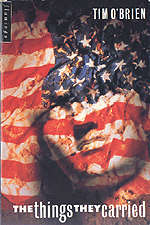 Publisher's
Summary Publisher's
Summary
"Works its magic at many levels. On the surface it is a sequence
of award-winning stories about the madness of the Vietnam War; at the
same time it has the cumulative power and unity of a novel, with recurring
characters and interwoven strands of plot and theme. The result is a
compelling and definitive summation of America's involvement in the
war and its coming to terms with that experience in the years since.
But white Vietnam is central to The Things They Carried, it is not simply
a book about war, it is also a book about the human heart - about the
terrible weight of those things we all carry through our lives."
Review
Arbitrary devastation and daily mundanity sit cheek-by-jowl in a thought-provoking
portrait of this war. O'Brien portrays the humanity of the soldiers more
clearly with a delicately embellished list of the items they carry than
most writers achieve with their almost obligatory mention of men's age,
hometown and marital status. As with his other novels, there isn't a lot
of military detail (most interesting is probably his mention of the platoon
as fielding a mere 17 men), but it has enough merit to make it worth reading
nonetheless. |

The 13th Valley 
John
M. Del Vecchio
Sphere Books, 1982 - ISBN 0-7221-8837-4 |
|
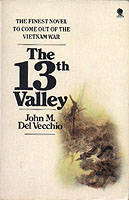 Publisher's
Summary Publisher's
Summary
"The war was Vietnam, the troops American. But the soldiers could be
any soldiers, the war any war fought for a distant cause by raw recruits
thousands of miles from home.
It is 1970. The tide of war has turned. The antiwar movement back
home wants peace. Troop withdrawals have begun. But in the whispering,
deadly jungles of Vietnam 101st Air Division have a mission. They can
still run and shoot and hide and love and hate and scream. They can
still fight and live and die in THE 13th VALLEY."
Review
A battalion of the 101st Airborne is sent into an isolated river valley
not far south of the DMZ to locate and destroy an NVA regimental HQ in
an isolated river valley. This fictionalised account, based on the composite
of a number of real engagements, centres on the Alpha Company and in particular
a new recruit and his short-timer sergeant.
The account contains a considerable amount of company level military
detail, which is ideal for fleshing out the scenarios used for most
wargames.
It's written competently but the characters are a little bit wooden,
and a little bit cliched. There is the innocent newbie, the cynical
veteran, the cowardly shirker, the black with the 'this is a white man's
war' chip on his shoulder etc.etc. The book also contains a considerable
amount of philosophical discussion on the nature of the War, war in
general and the rights of government, mostly in the guise of a book
that the Lieutenant commanding the company is working on. Caught between
a personal level novel and a factual account of a battle, it doesn't
work as well as it might as either. The cover proclaims it to be 'The
finest novel to come out of the Vietnam War'. Unfortunately it isn't.
|
More Vietnam book reviews can be found at the GRUNT
site.
|
